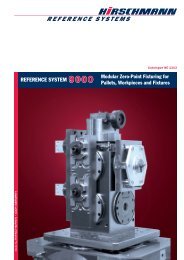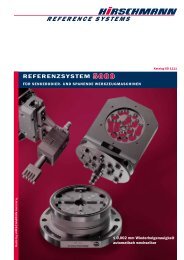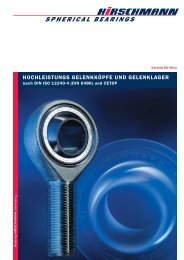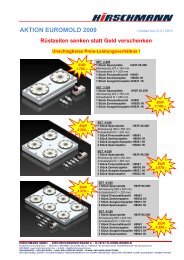heavy-duty rod ends and spherical bearings - Hirschmann GmbH
heavy-duty rod ends and spherical bearings - Hirschmann GmbH
heavy-duty rod ends and spherical bearings - Hirschmann GmbH
You also want an ePaper? Increase the reach of your titles
YUMPU automatically turns print PDFs into web optimized ePapers that Google loves.
Type of load<br />
invariable<br />
pulsating<br />
variable<br />
Fig. 11<br />
The values written in brackets are valid for <strong>rod</strong> <strong>ends</strong> with<br />
male threads <strong>and</strong> lubricating nipples or lubrication holes.<br />
It is necessary that: P P or<br />
perm.<br />
time<br />
time<br />
time<br />
P o P perm.<br />
Service life:<br />
The service life of a <strong>rod</strong> end or <strong>spherical</strong> bearing is a function<br />
of several factors, some of which are difficult to determine.<br />
A precise calculation is therefore not possible.<br />
The calculation method following, which has been proved<br />
correct in many test st<strong>and</strong> trials, gives a relatively accurate<br />
result for the service life. Influences as shocks, vibrations,<br />
soiling etc. are not taken into consideration. This<br />
calculation is based on a total abrasion of the linings of<br />
0.3% of the diameter of the inner ring. The coefficient of<br />
the sliding friction of the linings increases of about 0.25.<br />
Gh =<br />
Gh = service life<br />
C = dynamic bearing capacity<br />
[h]<br />
[N]<br />
P = dynamic equivalent bearing load [N]<br />
K = inner ring diameter [mm]<br />
= swing angle 1 [degrees]<br />
(by pivoting movements = 180°)<br />
b1 · b2 · b3 · 107 ·<br />
C__<br />
K · · f--- P<br />
f = swing frequency [rpm]<br />
b1 = load direction factor (Fig. 12)<br />
b2 = temperature factor (Fig. 12)<br />
b3 = material factor (Fig. 13)<br />
Operating- Load direction Temperature factor<br />
factors factor b1 b2 Load direction Temperature [° C]<br />
Bearing type single alternat. 80 100 150 200 250<br />
direction direction<br />
lubricated 1 2,5 1 1 1 0,8 0,5<br />
maintenancefree<br />
1 0,3 1 1 0,8 0,5 0,3<br />
Fig. 12<br />
Very low loads or running speeds result in a relatively high<br />
arithmetic service life. In practice, with a longer service life,<br />
environmental influences can acquire importance <strong>and</strong> lead<br />
to an error in the results.<br />
Material factor b3<br />
Material factor b3 –– –– –– Maintenance-free bearing<br />
––––––– Lubricated bearing<br />
If the required service life is not obtained, repeat this calculation<br />
with next bearing size up.<br />
Checking of linings for overheating:<br />
Permissible running speed:<br />
The permissible running speed is largely a function of the<br />
surface exerted, the friction pairing, the lubrication <strong>and</strong><br />
cooling if applicable. The heat building up in the bearing is<br />
proportional to the p<strong>rod</strong>uct of surface pressure <strong>and</strong> running<br />
speed. When checking the bearing size, therefore the<br />
p · v value must be determined <strong>and</strong> compared with the<br />
permissible value (Fig. 14). The bearing running speed<br />
must also be checked.<br />
To avoid overheating, the following is necessary:<br />
<br />
NNN ____<br />
mm2 · nmn ____<br />
<br />
p·v (p·v) perm.<br />
min<br />
v v perm.<br />
Load ratio C__ P<br />
[m/min]<br />
p = surface pressure = kc · P __ C<br />
[N/mm2] kc = specific surface pressure (Fig. 4) [N/mm2] v = mean running speed =<br />
1,745 · 10-5 · K · · f [m/min]<br />
Guideline values for the permissible p · v -value<br />
(p · v) perm. perm. running speed<br />
Bearing type<br />
____ N<br />
mm2 m<br />
· ____<br />
min<br />
vperm. [m/min]<br />
swing pivot<br />
lubricated 30 15 60<br />
maintenancefree<br />
80 60<br />
Fig. 13<br />
Fig. 14<br />
9






